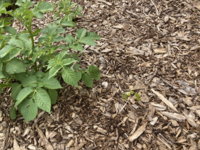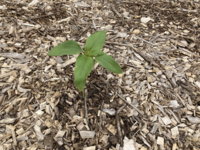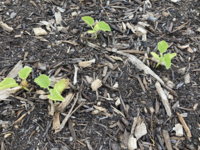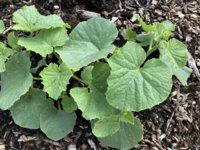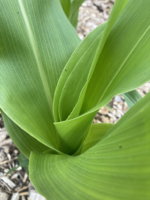I have been dawdling in the garden most days so the clock has been running on any updates. I also set up my own private cloud server at the house that now replaces Apple, Google, and every other data harvester and privacy seller of your family's data and I have not tweaked the app on my phone to leave photos so all my photos have been transferred to my private cloud server in the house. It feels awesome knowing all my data is mine again and no more nagging Apple 5GB photo limit reached every 3 days. My ancient old 2 Terabyte hard drive I haven't used for approaching a decade now runs my private cloud data backup and my old Samsung SSD runs the cloud data. I have oodles of free space and no nagging to pay monthly fees for the most miserable of data increases on public cloud companies.
I'll have to split the posts to catch up the latest in the garden.
First up we have had the worst weather ever. Freezes, Summer Weather, Major Storms, Winds Powerful Enough to lift up Dorothy's house and send it to Oz, you name it! This is just one rain event recorded the next day. Typical for this area, a deluge of rain in a drought period. Most folks just wash all that run down their gutters and into the street but I have captured it all in the woodchip garden conversion.

I planted a pound of cow peas (black eyes) and then three more the following week. These are the first of the first batch of plantings to emerge. I have zero fertilizer and zero watering of the woodchip garden conversion since last winter its just sat and done its own thing.

My severe pruning method to make tiny orchard trees has not killed off a single one of the fruit trees I ordered and put in for the Spring season. This was the last holdout, the Japanese Persimmon. It finally decided it liked to grow after all.

All the other fruit trees are just loving life.

Speaking of loving life, the potatoes are going great in the woodchips and loving every day. The Asparagus as well, though it gets another year to start developing the thicker spears my family loves.

My wife

Corn I am filling in some skips and finding the largest and fattest worms I have ever dug out of my garden which makes me really happy. Another three years of worm population increase through worms getting it on under the woodchips and I will have tons of worm castings ready to make the plants pop even more. These corn have roots growing through and interacting with the mushroom mycelium growing on the woodchips below the very top dry layer. An inch or so down and everything is damp and moist.

Sweet potato slips getting a start in the action. I shut down the sweet potato slip growing and just planted everything I had out into the chips.

Native American grapes are waking up and taking off.

Bean rows are starting to wake up and grow. Notice I had to put some of the branches I got cutting down my front yard tree the previous year into action during the massively powerful high winds we had so that the trellis structures didn't lift up and join Dorothy on the trip to the land of Oz. These worked awesome for the task.
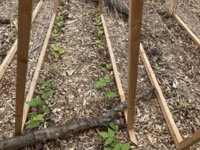
Not sure if I ever got in tobacco plant out photos, but this was the front yard. Little Yellow in the back and orientals up front.

During all this storm and weather chaos I decided to do a little pressure cooking of cavendish.

Worked a treat and to dry I used my large metal bowl as a solar collector, a front yard tree stump piece as a high winds weight and one of my unused growing totes as an outdoor drying chamber complete with bug screen. This worked so well, by 2 or 3 in the afternoon all the cavendish tobacco was completely in low case and dry'z'bone.
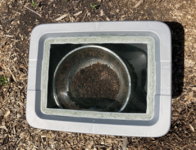
I'll have to split the posts to catch up the latest in the garden.
First up we have had the worst weather ever. Freezes, Summer Weather, Major Storms, Winds Powerful Enough to lift up Dorothy's house and send it to Oz, you name it! This is just one rain event recorded the next day. Typical for this area, a deluge of rain in a drought period. Most folks just wash all that run down their gutters and into the street but I have captured it all in the woodchip garden conversion.

I planted a pound of cow peas (black eyes) and then three more the following week. These are the first of the first batch of plantings to emerge. I have zero fertilizer and zero watering of the woodchip garden conversion since last winter its just sat and done its own thing.

My severe pruning method to make tiny orchard trees has not killed off a single one of the fruit trees I ordered and put in for the Spring season. This was the last holdout, the Japanese Persimmon. It finally decided it liked to grow after all.

All the other fruit trees are just loving life.

Speaking of loving life, the potatoes are going great in the woodchips and loving every day. The Asparagus as well, though it gets another year to start developing the thicker spears my family loves.

My wife

Corn I am filling in some skips and finding the largest and fattest worms I have ever dug out of my garden which makes me really happy. Another three years of worm population increase through worms getting it on under the woodchips and I will have tons of worm castings ready to make the plants pop even more. These corn have roots growing through and interacting with the mushroom mycelium growing on the woodchips below the very top dry layer. An inch or so down and everything is damp and moist.

Sweet potato slips getting a start in the action. I shut down the sweet potato slip growing and just planted everything I had out into the chips.

Native American grapes are waking up and taking off.

Bean rows are starting to wake up and grow. Notice I had to put some of the branches I got cutting down my front yard tree the previous year into action during the massively powerful high winds we had so that the trellis structures didn't lift up and join Dorothy on the trip to the land of Oz. These worked awesome for the task.

Not sure if I ever got in tobacco plant out photos, but this was the front yard. Little Yellow in the back and orientals up front.

During all this storm and weather chaos I decided to do a little pressure cooking of cavendish.

Worked a treat and to dry I used my large metal bowl as a solar collector, a front yard tree stump piece as a high winds weight and one of my unused growing totes as an outdoor drying chamber complete with bug screen. This worked so well, by 2 or 3 in the afternoon all the cavendish tobacco was completely in low case and dry'z'bone.





